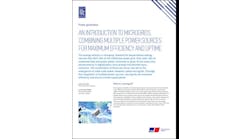Another ‘Doggone’ Good Microgrid in Montgomery County, Maryland
On November 27, 2022, a small airplane crashed into the high tension power lines feeding Montgomery County, Maryland. The plane’s occupants survived, but the incident knocked out power to thousands of customers – including the Montgomery County Animal Shelter.
Fortunately for the furry and feathered creatures calling the shelter home that day, a brand new microgrid kept the lights on and the occupants safe.
Just 10 days before the accident, GreenStruxture commissioned the shelter’s on-site renewable energy microgrid and, according to a statement from the company, it passed its first test with “flying” colors.
Jose Lorenzo, CEO of GreenStruxure, said, “While we would have never foreseen this type of scenario, we’re very proud to work with Montgomery County and to deliver for them in this first test.” GreenStruxure is a joint venture between Schneider Electric and Huck Capital, with ClearGen serving as a strategic partner.
Annette Clayton, CEO of Schneider Electric North America, agreed that the situation was unusual, but that it proved why the adoption of microgrids is important.
Microgrids power all types of critical infrastructure
Montgomery County considers the animal shelter a critical facility as it provides animal control and adoption services as well as an animal medical facility. The shelter primarily cares for dogs and cats but is also home to the occasional bird, turtle, rabbit, guinea pig and pet mouse (Beverly Cleary fans may be interested to know that Ralph S. Mouse is currently in residence, though the location of his motorcycle is unclear).
“We have a state-of-the-art, elite certified animal shelter and this was the next step in making it more resilient and sustainable,” said Michael Yambrach, chief, Office of Energy and Sustainability at the Montgomery County Department of General Services.
The microgrid includes solar carports and rooftop solar, a microgrid controller, backup generators and a digital monitoring system.
When the power was lost on Nov. 27, the microgrid automatically switched into island mode, drawing on the system’s backup power to ensure the shelter’s critical systems stayed on for the duration of the outage.
“The microgrid delivered as expected, continuously powering the site until utility power was restored three hours later,” said Denise Wade, property manager at the animal shelter. She added, “Our animals and staff remained safe; we reported no problems at our site and no business impact.”
Protecting all members of the community (regardless of the number of legs)
Montgomery County has launched several microgrid projects in recent years, including one of the nation’s first microgrid-powered electric bus depots. The county has two other microgrids, one at its public safety headquarters in Gaithersburg and another at a correctional facility in Boyds.
While the other projects serve a distinctly human audience, an on-site microgrid at the county animal shelter in Derwood was a natural fit, according to county administrators.
“The animals and our employees who take care of them were able to seamlessly continue their operations because they were connected to the microgrid,” said County Executive Marc Elrich.
Yambrach said, “During any outages or weather events, we want our residents to know that animals under our care are safe and protected, and our critical operations for animal control are uninterrupted.”
Elrich added that incidents like the plane crash are “exactly why we invest in these partnerships. They provide safety, sustainability and resiliency to all who reside in Montgomery County – whether they have two legs or four.”
Track news about the Montgomery County microgrids and other groundbreaking projects. Subscribe to the free Microgrid Knowledge newsletter.








